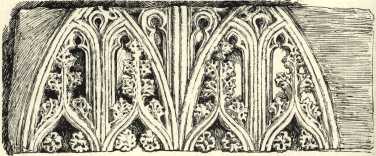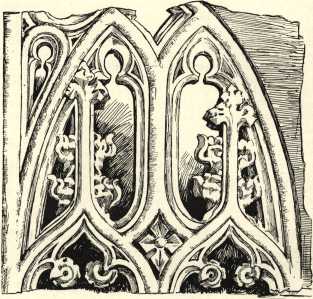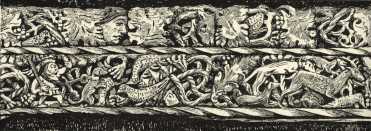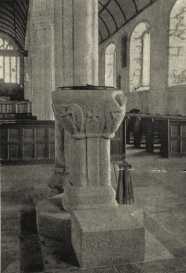| First Page | Previous Page | Next Page |
On August 26, 1238, the church of St. Buryan
was dedicated by the Bishop of Exeter, the Act of Dedication
being still extant, as is also a Vidimus of the original
dedication by King Athelstan.1
The clergy of the church were secular canons of the Order of
St. Augustine, bound to pray daily for their founder.
 We trust they were mindful
of this obligation. We know from the Valor Ecclesiasticus that
in the time of Henry VIII. the college distributed yearly 4s.
to the poor on the Obit of Athelstan. The chief feature of
interest in the Foundation was that it was for a considerable
time a Royal Peculiar. The King (or the Duke of Cornwall) could
appoint whom he would as Dean, without any interference on the
part of the Bishop; and the Dean, when appointed, had absolute
ecclesiastical jurisdiction over the parish of St. Buryan, with
its dependent parochial chapelries of St. Sennen and St. Levan,
both of which were served by clergy from the college. An appeal
from the Dean was direct to the Crown (or the Duchy), and not,
as in the case of ordinary peculiars, to the Archbishop. The
patronage of the benefice, now a rectory and shorn of its two
dependent chapelries, is still in the Duchy of Cornwall.
We trust they were mindful
of this obligation. We know from the Valor Ecclesiasticus that
in the time of Henry VIII. the college distributed yearly 4s.
to the poor on the Obit of Athelstan. The chief feature of
interest in the Foundation was that it was for a considerable
time a Royal Peculiar. The King (or the Duke of Cornwall) could
appoint whom he would as Dean, without any interference on the
part of the Bishop; and the Dean, when appointed, had absolute
ecclesiastical jurisdiction over the parish of St. Buryan, with
its dependent parochial chapelries of St. Sennen and St. Levan,
both of which were served by clergy from the college. An appeal
from the Dean was direct to the Crown (or the Duchy), and not,
as in the case of ordinary peculiars, to the Archbishop. The
patronage of the benefice, now a rectory and shorn of its two
dependent chapelries, is still in the Duchy of Cornwall.
The first incumbent of this benefice of whom we have record is Walter de Gray (February 12, 1213), who at the same time held St. Probus. Whether he was Dean or not we do not learn; but we assume that, whether so called or not, that was really the position he held. We believe he subsequently became Bishop of Winchester. William, Provost of St. Omer, succeeded (1214). In December 1220, William de Sancto Albino (St. Aubyn) was instituted, on the collation of the Legate, Pandulph, in the name of the King (Rot. Claus. 5 Henry III. m. 18). In 1301 King Edward I. granted the ‘Deanery of our Free Chapel of St. Buryan’ (decanatum Libere Capelle nostre Sancte Beriane) to Ralph de Mantone, Clerk, and commanded the Chapter to induct him into corporal possession of the same, and to render him due obedience as their Dean.
As might be expected, the Bishops of Exeter did not calmly suffer this Deanery to remain exempt from their ordinary jurisdiction, and constant quarrels were the result. On the death of Edmond, Earl of Cornwall, without heirs, and the consequent escheat of his earldom to the Crown, Edward I., claiming St. Buryan as a Royal Free Chapel, gave the Deanery to Sir William de Hameltone, his Chancellor and Dean of York. In 1292, Bishop Thomas de Bytton objected to the Dean as non-resident, and litigation ensued which was still pending when the Bishop died in 1307, litigation being apparently as slow then as it is now. On July 6, 1310, a Royal Writ was issued, dated at Westminster (received at Paignton July 28), calling on Roger Gruglan, Roger le Somenur (i.e. Apparitor) of Kerrier; Thomas, Vicar of St. Erth; Ralph, Rector of St. Gwinear, and several other clerics to appear before him, and explain how it was that, though St. Buryan was a Royal Free Chapel and had been so in the times of all his ancestors, Kings of England, and exempt from the ordinary jurisdiction, yet they had vi et armis broken into the said chapel, and had presumed to exercise the ordinary jurisdiction therein, and had moreover insulted the Dean, his men and servants whom they had found there, and had beaten them, so badly indeed that the lives of some of the servants were despaired of; and subsequently, because the said Dean and his men and servants had refused them admission at the time of the visitation, had pronounced sentence of excommunication against them, and had been guilty of other enormities, to the prejudice of the said King and of the Royal Dignity, and in manifest derogation of the liberty of the said chapel, and to the serious hurt of the said Dean, and against the peace &c.

The return to this writ is that their goods were
sequestrated; Ralph of St. Gwinear’s to the value of
20s., and of the others in smaller sums. But no execution had
been effected against Gruglan, because he had no benefice in
this diocese, or against Thomas, Vicar of St. Erth, or
Nicholas, Rector of St. Constantine, because no such persons
could be found in the diocese. It is clear from the writ that
St. Erth is named twice in error, as two persons are named as
vicars of that parish — namely, Thomas, who could not be
found, and Henry, whose goods were sequestrated to the value of
10s. — while ‘Nicholas’ is a clerical error
for Henry,  who at that time
held Constantine. The Bishop was probably only too well pleased
to take advantage of these clerical slips, as he always did
with obvious relish.
who at that time
held Constantine. The Bishop was probably only too well pleased
to take advantage of these clerical slips, as he always did
with obvious relish.
On June 24, 1318, Edward II. issued his prohibition to the Bishop of Exeter, forbidding his exercising any jurisdiction in the chapel of St. Buryan or over the ministers thereof, or attempting anything to the King’s prejudice in connection therewith, pending the decision of the plea in the King’s Court between him and the Bishop — the King asserting the chapel to be his free chapel, exempt from all ordinary jurisdiction, and the Bishop, on the other hand, claiming such jurisdiction and alleging that he and his predecessors always had exercised the same. The King at the same time issued his order to the Sheriff of Cornwall to maintain and defend the immunity and liberty of the aforesaid chapel, pending the said plea, or until further orders, and not to permit anyone to usurp upon the King by lay force.
In 1325 we find a foreigner, one John de Mante, as Dean, and a dispute on the subject going on between Queen Isabella and Bishop Stapeldon. Bishop Grandisson seems to have kept a careful eye on St. Buryan, with a view to finding grounds for intervening. An opportunity soon occurred which led to the Bishop excommunicating Mante for neglect of duty and disregard of the episcopal monitions. Many of the parishioners of St. Buryan seem to have taken the Dean’s side in the dispute, for in 1328 the Bishop issued a mandate for the citation of John le Archer, Roger de Penros, and others, including a lady, Margaret de Desdenewel, to appear before himself or his commissary. But they do not seem to have been as much frightened as they ought to have been at the episcopal thunderings, and, on August 17 of the same year, we find an order declaring them and others suspended and excommunicate. One of them, Vivian de Penros, was suspended from entering the church (ab ingressu Ecclesie); others were to be declared excommunicated in church, in chapel, and in all other public places; while the sentence on Richard Vivian, his son Hugo, and other ringleaders, was that they were to be declared ‘excommunicate, with tolling of bells of churches and chapels, with candles lighted and extinguished in public, and with all due solemnity.’2
On September 3, 1328, several of the parishioners were inhibited from communicating. The parishioners in this strait obtained the services of one John Kaer, ‘declaring himself to be the parish priest of St. Buryan.’ On November 4, 1328, Bishop Grandisson, being then at St. Michael’s Mount, did, in the presence of his chaplains and other clergy, vested in stoles and with burning candles in their hands (stolis indutis et candelis accensis in manibus eorum), fulminate sentence of excommunication against the rebellious people of St. Buryan, and against the said John Kaer for that he did ‘celebrate the Divine Service, nay, rather, profane it, in the presence of certain excommunicate and schismatical parishioners of St. Buryan in a place now accounted prophane and under an interdict,’ both the church and the churchyard having been polluted by bloodshed. Especially severe was his Right Reverence against Richard Vyvyan, who is described as ‘the author, promoter, and inciter of the many evil and flagitious deeds perpetrated in the said parish;’ but all who ventured to communicate with the offenders were included in the curse, which he solemnly pronounced, using the accustomed formula: ‘As these lights are extinguished before our bodily eyes, so, in the presence of God and of Blessed Mary, the Blessed Angels and all Saints, may their soul be extinguished and delivered to the devil and his angels for endless punishment in everlasting fire, unless they repent and come to a better mind. Fiat! Fiat!’ However, forgiveness for the good people could be obtained by acknowledging the Bishop as their spiritual father, and taking the oath of submission to the mandates of the Church.
In the following year we find the King, Edward III., interfering to protect the Dean. The Dean and a large number of other people, including Richard Vyvyan, having been indicted for seizure of the goods and chattels of Richard de Beaupre at the town of St. Berian, Trethin, Trendraenen and Tredeney, and for other trespasses, before Thomas le Ercedekne and his fellows, justices of the peace for Cornwall; and the King, understanding that the indictments were made at the procuration of the said Sir Richard de Beaupre, pretending to be the prebendary of Trethin in the King’s free chapel of St. Berian, and that the goods and chattels in question had been sequestrated by the Dean as fruits of the prebend, Sir Richard’s right to which he disputed, and willing that the matter should be settled before himself, by letter dated March 8, 1329, ordered the sheriff to release those whom he had imprisoned by reason of the premises, upon their finding mainpernors to have them before the King in fifteen days from Easter, to stand to right concerning the said indictment. We do not know the immediate sequel of these proceedings, but they probably did little to turn the Bishop from the course he had laid down for himself.

Some time in the year 1333 the Bishop ordered De Mante, ‘who represents himself to be Dean of the parish church of St. Buryan’ (qui pro decano Ecelesie Parochialis Sancte Beriane . . . se gerit), to be denounced as excommunicate for refusing to pay the ‘tenths’ imposed by the Pope. The ceremony was to be accompanied by the usual bell-ringing and candle-extinguishing. But 1336 found the parishioners in a happier frame of mind. In this year, on July 12, the Bishop visited St. Buryan again, and this time as ordinary and diocesan; and the good folk (including John Kaer the parish priest) came in and acknowledged their wrong and were again received into the bosom of the Church. An interesting feature of the ceremony was that some of the penitents did not know any language but Cornish, and Henry Marsley, rector of St. Just, had to act as interpreter. The ceremony closed with the singing of Veni, Creator Spiritus, and a sermon from the Bishop, who took his text from the First Epistle of St. Peter: ‘For ye were as sheep going astray; but are now returned unto the Shepherd and Bishop of your souls.’ The interpreter repeated the sermon in the Cornish tongue when the Bishop had finished, and then followed a great many confirmations, and several natives of St. Buryan were also admitted to the first tonsure.
But among the penitents was not found John de Mante; far from it, for, as the Bishop sadly puts it, he was neither ashamed nor afraid to remain excommunicate, and to withdraw himself, in his disobedience, from the unity of the Church (decedere ab unitate Ecciesie per inobedienciam non erubescit nec expavet). So Henry Marsely, whom we have just encountered as an interpreter, was, on July 14, 1336, appointed by the Bishop as guardian (yconomus) of the Church, with full canonical powers.
But even this troublesome and contumacious Dean could not hold out for ever against the firm and persistent Bishop Grandisson; and on August 16 following, he came to Bishop’s Clyst, and in the presence of the Bishop took a solemn oath of submission and obedience, promising amendment for the future. He would faithfully obey the Bishop’s advice, counsel, and decrees; but he was permitted to add: ‘saving the royal rights in the said Deanery and his own person.’ So he got plenary absolution and (what he possibly valued more) was restored to the enjoyment of the profits of his benefice.
The visitation of his diocese is and has always been one of the chief duties of a Bishop — a duty implied of course in the very name.
On the occasion of these Visitations, Bishops frequently travelled in great state with a large retinue, and taking with them what was called their ‘Chapel,’ so much so that many Councils found it necessary to admonish them not to be too burdensome to their poorer clergy.

The Bishop was met with much ceremony on his entry into the parish, and was escorted to the church, where service was held and he gave the people his blessing, and explained the object of the Visitation, and prayed for its success. The most gratifying part of the service to the parishioners was probably the grant by the Bishop of forty days’ indulgence — a word which, by the way, is not to be understood in its modern sense; it meant pardon — the remission of penance imposed for past sins. Service over, the Bishop was vested in his amice and a purple (or black) stole and cope, and proceeded to the churchyard, where he said the De profundis (i.e. Psalm 130) and prayers for the faithful departed.
In the dispute as to the patronage of the Deanery, victory was, in the end, with the Crown and Duchy, and continued so from the time of Edward III. till A.D. 1850, when by Statute (13 and 14 Victoria, c. 76) the Deanery was divided into three Rectories, of St. Buryan, St. Levan, and St. Sennen; the office of Dean being abolished as from the death of the then Dean (the Hon. and Rev. Fitz-Roy Henry Richard Stanhope, who died in 1864);3 all peculiar and exempt jurisdiction was taken away, and all wills, seals, &c., ordered to be transferred to the Registry of the Archdeaconry at Bodmin.
The college shared in the general suppression of the Reformation, and its officers were pensioned off; the Dean, Thomas Bauge, receiving in 1553 25l. 17s. 4d. ; William Woodward, 5l.; Philip John, 41. 10s.; Lewis Jenkins, 2l.; Robert Whitster, 2l.
In 1555 there was paid to Philip John, a stipendiary in the church of St. Burian, called the King’s Priest, 41. 10s., and to David Barrghe, formerly Dean, 25l. 17s. 4d. The others were perhaps dead; at any rate, their names are not on the Roll of Fees paid out of the Exchequer (Add. MS. 8102, British Museum). David Barrghe is probably a mistake for Thomas Bauge.
It was evidently contemplated to make some change in connection with this parish somewhere between 1538 and 1566, as among the State Papers in the Public Record Office is a petition of the ‘whole paryshe of St. Buryan’ to the Lord Treasurer and the Barons of the Exchequer, asserting theirs to be a parish church and to have been so time out of mind, the parson having ‘the cure and charge of fifteen hundred comunycatinge people being within his said cure as the estate thereof may most manyfestly appear unto your honoure by deposicons remayning of record which hath byn so tryed heretofore as by the record and judgement in the Courte of Exchequer appeareth.

ST. BURYAN FONT
So yt ys righte honorable Lorde that certen covetuouse personns for theire owne gredines have procured an informacon agaynste our incumbent John Guyer touching the estate of our Church supposing the same to he a Deanrye.’ The ‘power orators’ pray that an early day may be fixed for determining the matter. Probably they did not care whether the establishment was called collegiate or not; they were only anxious that the cure of souls should be recognised as part of the duty of the Dean and Prebendaries. There is among the papers a plan of this and the adjacent parishes of apparently the same date.
During the Commonwealth two Deans of St. Buryan seem to have suffered ejection — namely, Robert Creyghton and John Weekes.
1 Grandisson’s Regr. vol. ii. fol. 25, b, 26. There is nothing in Athelstan’s grant (if, that is, we may assume it to be correctly set forth) that anywise justifies the claim of the Deanery to freedom from episcopal control, and the words of Domesday certainly do not support such a position.
2 The cursing by ‘bell, book, and candle’ has been said to be a Protestant fabrication, and there are many who believe it can be found only in works of fiction, such as Tristram Shandy and The Ingoldsby Legends. The above, however, is one only of the several instances where it is referred to in the Episcopal Registers. In his illustrations to Shakespeare, Halliwell quotes the following from Nares, who in his turn quotes from the Canterbury Book: ‘The prelate stood in his pulpit in his albe, the cross was lifted up, and the candles lighted, when he proceeded thus:— “Thorow authoritie of Lord God Almighty, and our Lady S. Mary, and all the saints of heaven, of angels and archangels, patriarches and prophets, evangelists, apostles, martyrs, confessors, and virgins; also by the power of all-holy church, that our Lord Jesu Christ gave to S. Peter, we denounce all those accursed that we have thus reckned to you: and all those that maintaine hem in her (id est, ‘them in their’) sins, or given hem hereto either helpe or councell, so that they be departed from God, and all-holy church, and that they have noe part of the passion of our Lord Jesu Christ, ne of noe sacraments that been in holy church, ne noe part of the prayers among christen folke, but that they be accursed of God and of holy church, from the soul of their foot unto the crown of their head, sleaping and waking, sitting and standing, in all her words, and in all her workes, and but if they have grace of God for to amend hem here in this life for to dwell in the pain of hell, for ever withouten end, fiat, fiat. Doe to the book, quench the candle, ring the bell. Amen, Amen!”’
3 Stanhope does not appear to have ever come into residence. It is said that no English Bishop could be induced to ordain him, and that his Royal friend sent him to Ireland for the purpose with this note of introduction: ‘Ordain Stanhope, Yours York,’ to which, in due course, came the reply ‘Stanhope’s ordained, Yours Cork.’
The sacred vessels of the church now are two flagons of pewter presented in 1684 by Dr. Phillips, a chalice of silver of the same date, weighing fifteen ounces, the gift of Dr. Nicholas Phillips, and a silver paten weighing 12 oz. 5 dwt., the gift of Francis Hocken in 1740.
The bells are three:—
One interesting relic is an altar-cloth worked by two maiden ladies, the Misses Davies, towards the end of the seventeenth century, and still in occasional use. In the Transactions of the Penzance Natural History Society (vol. ii. p. 293) is an account of the discovery of two urns in ground then (1886) recently added to the churchyard, and on the supposed site of the ancient chapel of St. Clare. We can trace no reference to this chapel in any ancient document.
There were also formerly the ruins of at least two other chapels in this parish, one by the seaside on the manor of Treviddron, dedicated to St. Loy or St. Dillower, and the other on the estate called Vellanserga.
| First Page | Previous Page | Next Page |